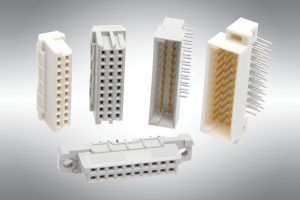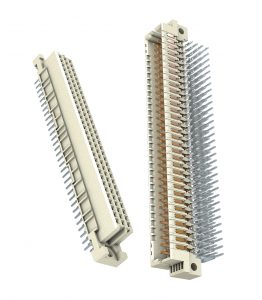
How DIN components keep finding new relevance
By Phill Shaw, senior product manager for board level products, HARTING North America
Electronics Interconnect Contract Manufacturing Engineering Supply Chain connectors connectors IEC 61 076-4-113 standard standard DIN 41 612As newer connector designs evolve, offering higher transmission speeds and smaller contact spacing, some traditional connector series continue to develop new features of their own to maintain market relevance. Take the standard DIN 41 612 electrical connector. Its demise has been predicted for many years, yet it remains a viable, even preferred choice for many applications because the series is constantly being rejuvenated with new variants that add functionality or can provide benefits during assembly.
The connector manufacturing world has focused increasingly on ultra-high-speed surface mount fine pitch, board-to-board and wire-to-board connectivity sought by customers. In the process, many vendors have de-emphasized their DIN 41 612 offering, resulting in part number obsolescence and fewer variants in their portfolios. While embracing these newer technologies, a few of us still see a bright future for DIN and intend to support that user community with a full range of products indefinitely.
DIN 416 12 connectors offer certain market segments a better business case. The technology is proven and reliable – having been an industry staple for four decades. These connectors are robust, offering a long service life – 20 years or more, often under harsh conditions – that makes them a highly trusted solution for OEMs. There are a range of termination options, such as press-fit, solder and crimp for many variants, allowing the user ease of processing from the prototype stage through to high volume production.
Connectors to reach speeds up to 3.125Gb/s
The ability of DIN connectors to reach speeds up to 3.125Gb/s with selective pin assignments is perfectly adequate for applications in many industrial sectors, such as rail, military, energy generation, transmission and management, automation and machinery. Often, they are more cost effective than newer, higher speed connector styles offered as alternatives. They are familiar to experienced hardware designers, and being standardized products, compatibility among suppliers is assured.
DIN 41 612 was conceived as a two-piece connector system for 19’’ modular sub-racks and was widely adopted in telecom applications (backplane to daughter card).The standard was introduced in 1976 (evolved from an earlier German military VG standard) and was subsequently updated to IEC 60603-2, which describes electrical connectors that have two or three rows of contacts with 16 or 32 columns per row, with contact spacing of 0.1” (2.54mm). These connectors have a variety of pin counts depending on body type with a maximum of 96 contacts in 3 rows, and form the basis for a much wider range of complementary products which are not covered by the standard. In 1996 the new IEC 61 076-4-113 standard was written, for VME 64x architecture. The HARTING har-bus 64 range of connectors was developed, offering connectors with 160 pins, while still maintaining full backward compatibility with traditional 96 pin DIN 41 612 connectors. VME 64x offers additional functionality beyond the traditional VME standard, further extending the life of the DIN 41 612 family of products.
While telecom industries have moved on to connectors with ultra high speed capabilities, the popularity of DIN 41 612 has led many other industries to seek variations to support their unique needs. That has led to a steady stream of enhancements, modifications and complementary versions, such as:
* NFF certified DIN 41 612 connectors to address safety requirements against flammability and gas emissions in rail cars.
* Rugged metal housings that offer high levels of EMI protection.
* ‘Through Hole Reflow’ (THR) versions that reduce processing costs on a board that uses both through hole and SMT components. These THR versions are made from plastics that can tolerate higher solder temperatures and can be terminated during the same reflow step as SMT components, thereby reducing the overall manufacturing cost by avoiding the need for a separate wave solder or hand solder step.
* One-half and one-third variant sizes for smaller circuit boards that deliver more I/O capability with minimal space usage compared to full length versions
* Hybrid versions which combine signal contacts with power, coax, or fiber optics, in one connector. By combining different functions in one connector, it is possible to reduce the number of components and save space.
DIN variants are available in inverse styles, where the traditional male angled/female straight termination styles are reversed. In addition to allowing freedom of choice for connector gender on the backplane and daughter card, it also opens up the possibility for DIN connectors for parallel stacked boards, or co-planar boards.
Those one-third and one-half sized variants specifically address customer demand for miniaturization and pcb board space optimization. HARTING, for example, has now added a type 3C crimp version to its family of one third size connectors. This family also includes inverse 3Q and 3R male and female connectors, making the one third length family as versatile as the full length versions, but with the benefit of space saving. As with the full-length connectors the one third versions with 20 or 30 contacts are rated at up 2 amps per contact.
While DIN 41 612 is a standardized product series, vendors are willing to provide customers with customized solutions, like special coatless zinc die-cast housings for train control modules for rail giant Bombardier and connectors with special flanges for use in a custom backplane for another rail leader, Alstom. While standard DIN connectors are delivered according to the performance levels defined by the IEC specifications, some vendors, including HARTING, also offer customer specific plating.
You can identify DIN manufacturers committed to the future of the technology by how they meets five tests:
1. Do they provide continual support in selecting a product backed by strong after sales support?
2. Do they offer a broad portfolio from which to pick to get the best solution?
3. Do they evolve products to meet market trends, thereby keeping DIN 41 612 technology relevant?
4. Do they perform thorough testing of their new products, both for durability and reliability?
5. Are they investing in their own manufacturing capability – renewing their stamping, molding and assembly tooling to ensure continued, reliable supply of product?
In pcb design today, there are many applications where the newest ultra high speed designs might not be the best choice, all things considered. Why pay a premium for capabilities that aren’t needed, or for components that may be less durable in challenging operating conditions? With DIN 41 612, a world of possibilities remain for tried and true, economical solutions that deliver everything a successful project requires.


